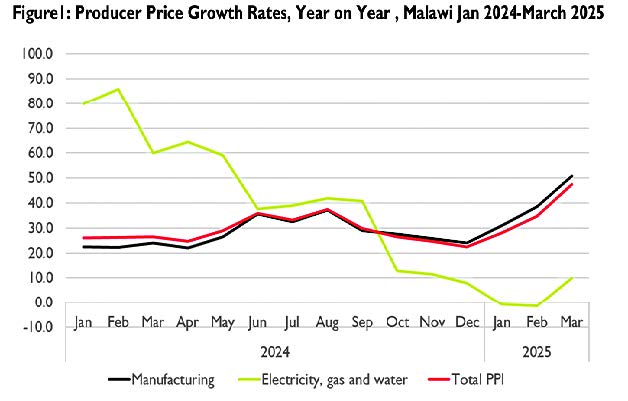
Malawi’s Rising Costs: 37.6% Producer Price Surge in Q1 – What It Means for Your Business
Key Business Points
- Rising producer prices: Malawi’s producer prices have increased by 37.6 percent in the first quarter of 2025, driven by soaring food processing costs and inflation, which may lead to narrowed profit margins and cash flow challenges for local businesses.
- Manufacturing sector impact: The surge in producer prices is largely driven by the rise in prices for manufactured food products and plastic products, which may force small and medium enterprises to scale down production, delay investment, or downsize staff, ultimately affecting zinthu zokwera (business operations).
- Mitigation strategies: Businesses can consider using locally available ingredients, reducing packaging sizes, and shifting toward recycled materials to maintain affordability and reduce costs, as advised by the Malawi Confederation of Chambers of Commerce and Industry, while also exploring matole (solutions) to improve ulimiru (competitiveness).
Malawi’s business community is facing significant challenges due to the sharp rise in producer prices, which has increased by 37.6 percent in the first quarter of 2025. According to the National Statistical Office (NSO), the year-on-year average growth rate for the first quarter stands at 37.6 percent, up from 26.7 percent recorded between the fourth quarters of 2023 and 2024. Inflationary pressures at the production level remain persistent, with producer prices rising by an average of 19 percent between the fourth quarter of 2024 and the first quarter of 2025.
The primary cause of the increase in producer prices is the rise in prices for manufactured food products, such as cooking oil, bakery, and grain mill products. The manufacturing sector, particularly wafanyabiashara wadogo na wa kati (small and medium enterprises), is feeling the strain, with narrowed profit margins, increased operational costs, and cash flow challenges. The Malawi Confederation of Chambers of Commerce and Industry has expressed concern that high producer prices may erode business confidence and discourage long-term planning, potentially stalling ukuzi wa viwanda (industrial growth).
However, some experts are optimistic that the impact on consumer inflation and the cost of living may be limited. Gowokani Chijere Chirwa, an associate professor of economics at the University of Malawi, attributes the surge in producer prices partly to improved agricultural output, especially maize, which saw a production increase of 9.2 percent in the 2024/25 season. Chirwa notes that while producer prices are up, there are signs that mfundo wa chimidzi (inflation) is easing.
As wafanyabiashara (entrepreneurs) and biashara (businesses) grapple with the effects of rising production costs, they are exploring strategies to mitigate the impact. For example, food processors are using locally available ingredients, reducing packaging sizes to maintain affordability, while plastics manufacturers are shifting toward recycled materials and lighter product designs. The Manufacturers Association of Malawi has also noted that a slight improvement in power supply and a complete reopening from Covid-19 pandemic restrictions has improved industrial output, providing some matope (hope) for the sector. Ultimately, biashara za Malawi (Malawi’s businesses) will need to adapt to the changing economic environment to remain competitive and kupeza mapato (generate revenue).
What are your thoughts on this business development? Share your insights and remember to follow us on Facebook and Twitter for the latest Malawi business news and opportunities. Visit us daily for comprehensive coverage of Malawi’s business landscape.
- Empowering Malawi’s Economic Growth: MSME Act Set to Catalyze Business Expansion - October 27, 2025
- Stabilizing Maize Prices: A Catalyst for Malawi’s Economic Growth - October 25, 2025
- Fueling Malawi’s Trade Rise: How Digital Payments Are Supercharging SME Exports - October 25, 2025
